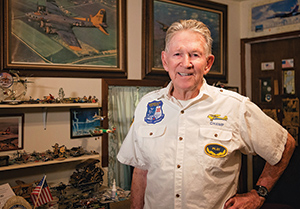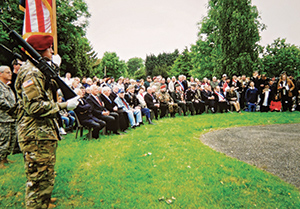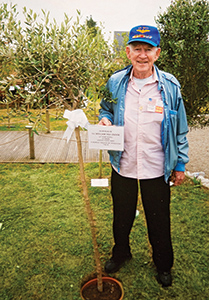Return to D-Day
On June 6, 1944—D-Day—thousands of Allied soldiers parachuted onto the beaches of Normandy, France. The day was a turning point in World War II that effectively began the liberation of Western Europe from Nazi control. The men and women who served or supported this operation will never forget that day, and neither will the citizens in France, who celebrate the sacrifices the Allied forces made for them and for their freedoms, those long decades ago.
 Bill Van Osdol has witnessed first-hand the respect and gratitude the locals in France still have today for the Americans and their allies. From period costumes and vehicles to reenactments—including a parachute drop of thousands—Americans are welcomed with open arms, and thanked profusely. Nowhere is more celebratory than in the town of St. Mere-Eglise, where D-Day ceremonies concluded with a seated dinner for hundreds of American veterans and active duty Army and Navy personnel.
Bill Van Osdol has witnessed first-hand the respect and gratitude the locals in France still have today for the Americans and their allies. From period costumes and vehicles to reenactments—including a parachute drop of thousands—Americans are welcomed with open arms, and thanked profusely. Nowhere is more celebratory than in the town of St. Mere-Eglise, where D-Day ceremonies concluded with a seated dinner for hundreds of American veterans and active duty Army and Navy personnel.
Honored Guests
“It’s unbelievable the pride they have for the Americans who liberated them,” says Van Osdol. “Wherever there are battle sites in France, you have it. They dedicate those sites every year to Americans. Put up American flags, every house in the neighborhood will have an American flag flying. They stand on the streets waving and yelling and saluting. People come up and want your autograph and picture—hundreds of them.”
Though Van Osdol’s first trip to the Normandy region was long after it was liberated, he felt connected to it through his service. On board a tender out of Plymouth, England, Van Osdol did supply runs to those living in the aftermath of the war.
 His most recent trip this past June was his sixth journey to France—and the only one where he was a guest of an association with ties to Oklahoma that sponsors veterans trips to battles sites and remembrance ceremonies all around Europe. He was part of a contingency that had over a week of morning-to-night planned activities, including meals, flower-laying ceremonies, and visits with dignitaries and locals alike. “One day we went out to tour an American cemetery and there was a group of schoolchildren there,” says Van Osdol. “They brought those students to shake our hands, each and every one of them.”
His most recent trip this past June was his sixth journey to France—and the only one where he was a guest of an association with ties to Oklahoma that sponsors veterans trips to battles sites and remembrance ceremonies all around Europe. He was part of a contingency that had over a week of morning-to-night planned activities, including meals, flower-laying ceremonies, and visits with dignitaries and locals alike. “One day we went out to tour an American cemetery and there was a group of schoolchildren there,” says Van Osdol. “They brought those students to shake our hands, each and every one of them.”
The mayor of a local town invited hundreds of guests to a five-course catered meal for lunch. On the final day of this visit, the veterans were honored at a private memorial.
“They planted an olive tree for us—that thing will last a thousand years,” says Van Osdol. A plaque with information about the veteran it honors is placed at the base of each tree, a copy of the plaque sent home with each veteran as a remembrance.
Previous Visits
On Van Osdol’s five previous visits to the WWII sites, he would split the cost with friends and go as a group. Occasionally they would get tickets to some of the events, but often the events were so crowded it was impossible to do so. “The wreath laying ceremony (at the Normandy American Cemetery and Memorial) would have maybe 15,000 people.” A highlight of one visit was the parachute drop recreation at St Mere Eglise. “Townspeople would walk to the town 10 miles from the highway where they parked their cars.” The commitment of the local citizens to honor their American heroes still brings a look of awe to Van Osdol’s face.
 “The celebration of D-Day in Normandy draws people from all over Europe,” says Van Osdol. “It looks like a WWII military vehicle parade.” Hundreds of vehicles such as jeeps and motorcycles were left behind when the American forces went home after the war.
“The celebration of D-Day in Normandy draws people from all over Europe,” says Van Osdol. “It looks like a WWII military vehicle parade.” Hundreds of vehicles such as jeeps and motorcycles were left behind when the American forces went home after the war.
History Keeper
Along with an extensive collection of WWII memorabilia—including over 2000 images of airplane nose art and a restored jeep and plane—Van Osdol has written two fiction and two nonfiction books on the time period. The stories he’s witnessed and those he’s heard underscore the enduring connection the time period has for many.
“One guy I know, he parachuted in on D-Day and was injured,” says Van Osdol. A young French girl found him and brought her brothers to try to help him, but they were unable to provide medical attention. “They turned him over to the Germans for medical help. Twenty-one days later, The Americans caught up with the German unit and got him back.” He was sent home and never knew what happened to the French girl—who also wondered what happened to the injured soldier. “On the 60th anniversary, in St Mere Eglise, the French girl had a sign with his name on it.” He was there and they reunited, sixty years later.
Another friend was a tailgunner on a B17, and was shot down over Germany. He bailed out and ended up in a German POW camp. After every mission, he would return to his Quonset hut and write it down on his Vargas calendar. Of course, on this last mission, he never returned to his hut and his calendar was left behind. “Forty years later at a reunion, a guy handed him his calendar—he’d saved it all those years.”
When asked when he plans to return to France, Van Osdol is realistic. With the aches and pains befitting a man of his years and experience, he knows it might not happen. But through his treasured collections and memories, he can always relive his visits to Normandy.




